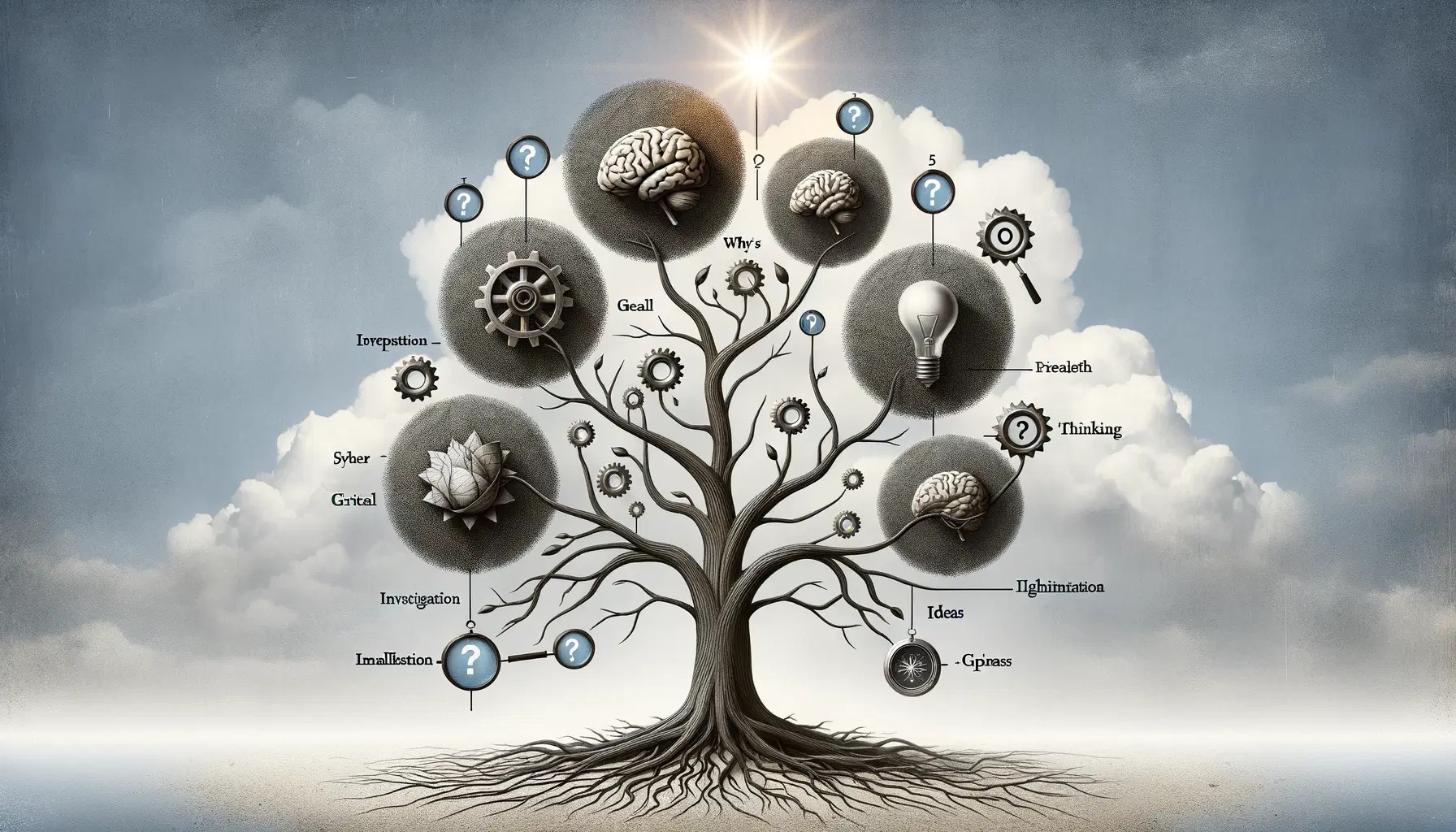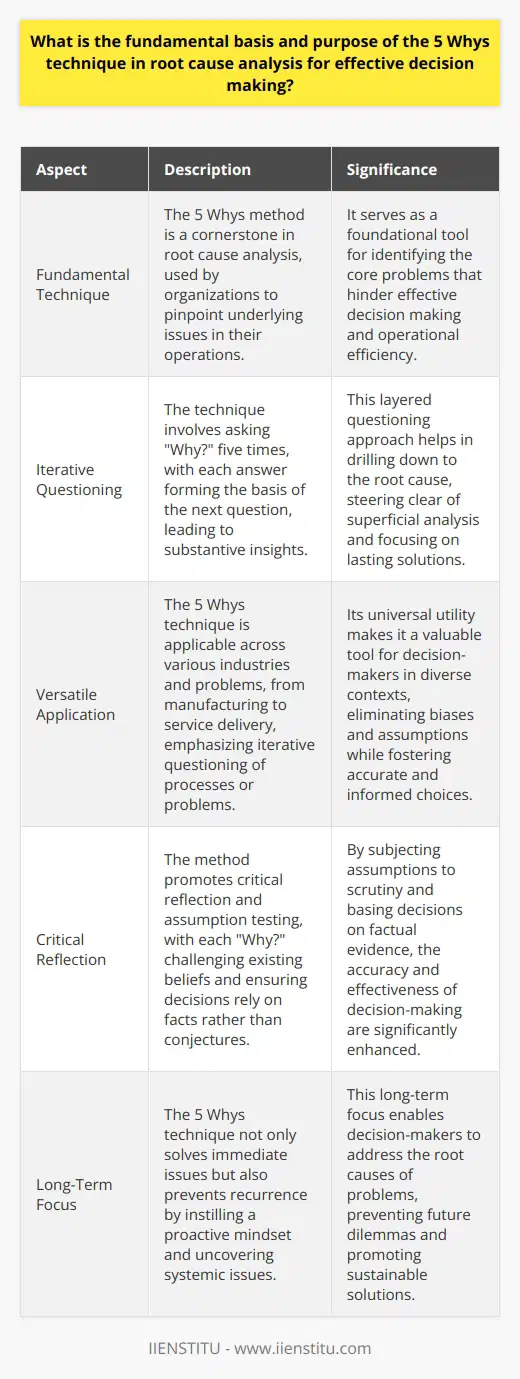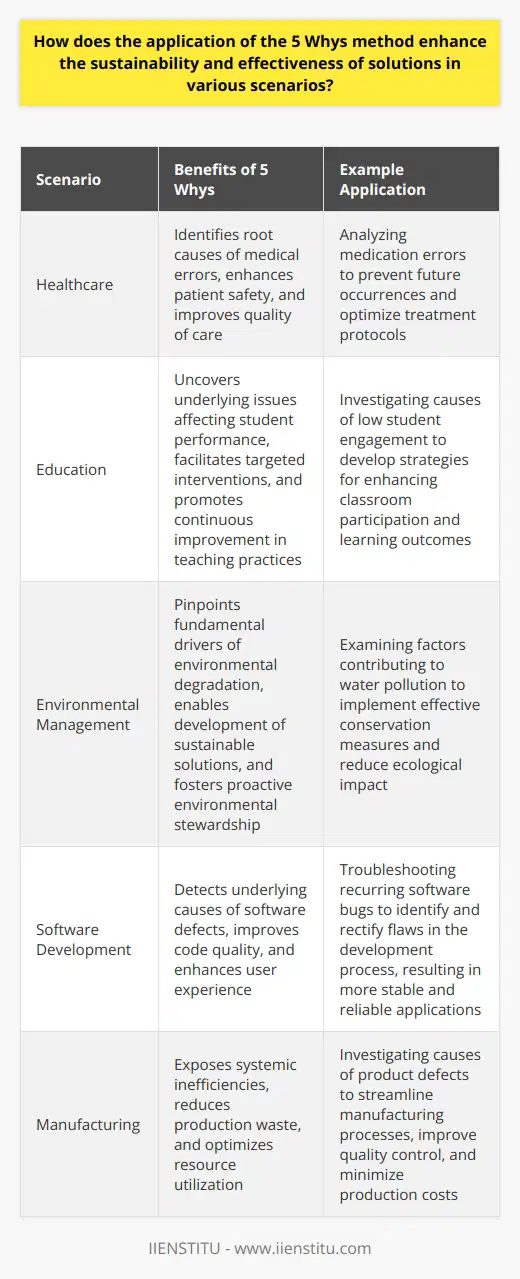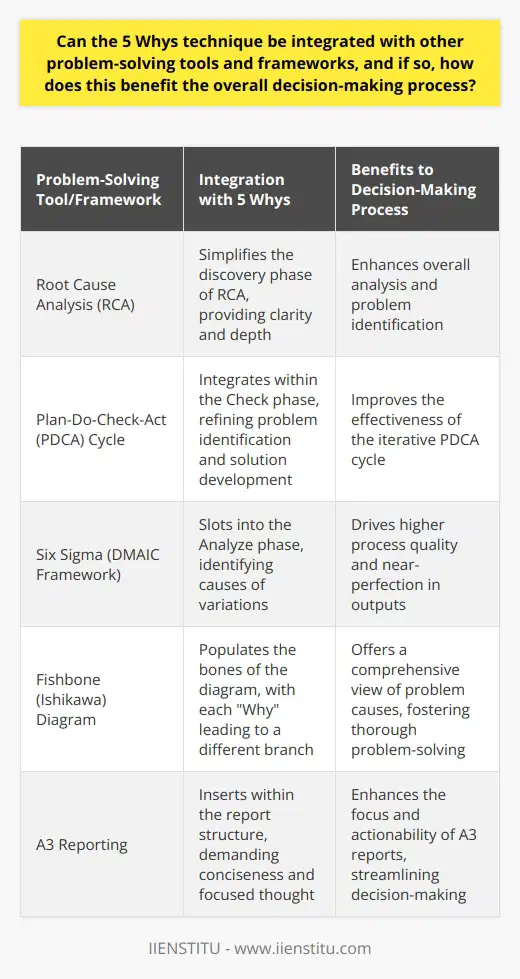
The ability to decisively identify and address the underlying issues in any problematic scenario is a vital skill in both personal and professional realms.
The "5 Whys" is a powerful, yet elegantly simple tool for root cause analysis that has been utilized successfully by organizations and individuals across the globe.
Originating within the hallowed halls of Toyota’s manufacturing process, the "5 Whys" has transcended its industrial roots, finding relevance in a variety of fields from IT to healthcare.
This article aims to explore the technique in depth, providing insight into its practical application and potential limitations alike.
Understanding the 5 Whys Technique
Detailed Definition and Overview of 5 Whys
The 5 Whys technique is the epitome of simplicity; at its core, it involves asking the question 'Why?' five times in succession.
This process of interrogative inquiry helps peel back the layers of symptoms that can often obscure the true cause of a problem. By repetitively questioning the cause of an issue, individuals and teams are guided to its origin, enabling more effective solutions to be formulated.
The effectiveness of the 5 Whys lies in its straightforwardness. It does not require complex algorithms or expensive software, just a curious mind and the persistence to delve deeper.
As an investigative tool for root cause analysis, the 5 Whys provides a structured yet flexible framework which fosters comprehensive understanding of problems at their source.
Failure Mode, Effects, and Criticality Analysis (FMECA): A Comprehensive Guide
Ishikawa Diagram (Fishbone Diagram): A Comprehensive Guide to Effective Analysis
Examination of its Origins and History
This technique is inextricably linked with the storied history of the Toyota Production System (TPS), where Taiichi Ohno, the father of TPS, developed it as a key component of Toyota's problem-solving culture. Its success within Toyota paved the way for its broader application across various industries, becoming a staple of quality improvement and lean management practices globally.
The evolution of 5 Whys has been shaped by its continual application across myriad sectors; each new adaptation has further refined and validated its efficacy. The widespread adoption underscores a universal truth: understanding a problem's foundation is essential to achieving lasting solutions.
Importance and Advantages of the 5 Whys Technique
The 5 Whys is first and foremost a problem-solving training tool. It equips individuals with a systematic approach to trace a problem back to its roots, ensuring that interventions are targeted and effective. This aspect of problem-solving not only saves time and resources but also encourages a deeper engagement with the operational processes of a business or personal project.
By incorporating real-life examples into training, the benefits of the 5 Whys technique become vividly apparent. Whether it's addressing a recurring technical fault in a product or analyzing customer feedback, utilizing the 5 Whys can dramatically refine the quality and precision of decision-making within any operation.
How to Use the 5 Whys Technique
Explanation of the Step-By-Step Process of Implementing 5 Whys
The implementation of the 5 Whys technique begins with the identification of the problem. Starting with a clear and concise problem statement, the first 'Why' addresses the immediate cause. Each subsequent 'Why' digs deeper into the preceding response until the fundamental cause is revealed.
Let's consider a scenario in an educational context where students are not completing their online certificate programs. The first 'Why' may reveal that the course materials are not engaging. The second 'Why' could probe into whether the content is too difficult or not relevant, and so on, until the root cause, perhaps an outdated curriculum design, is identified.
Usage of 5 Whys in Various Settings
The flexibility of the 5 Whys is one of its greatest strengths. It can be used independently for personal introspection or as a collaborative tool in team settings.
This versatility allows it to be beneficial in numerous scenarios from troubleshooting production line failures to improving customer service experiences.
For example, a manager might use the 5 Whys in a one-on-one setting to understand why an employee is underperforming, while a project team might apply it to uncover the reason behind a missed deadline. Each context lends itself to potent insights that foster proactive and reactive solution-oriented strategies.
Things to Consider When Using 5 Whys
While using the 5 Whys, it’s crucial to maintain an atmosphere of trust and transparency. Honesty in responses is pivotal, as misleading inputs can divert the process, leading to ineffective conclusions. Furthermore, it's essential to acknowledge that there may be more than one root cause. Thus, multiple iterations of questioning, targeting different facets of the problem, may be required.
Avoiding a blame culture is key; the goal is to focus on the problem, not the person. The process should be a constructive one, aimed at improvement rather than accusation. This approach ensures that the solution is not just a short-term fix but a stepping stone to a more resilient and efficient system.
Limitations and Criticisms of the 5 Whys
Examination of the Potential Shortcomings of the 5 Whys Technique
No technique is without its drawbacks, and the 5 Whys is no exception. The process relies heavily on the insight and experience of those involved; thus, subjectivity and bias can influence the direction and outcome of the analysis. This reliance emphasizes the need for diversity and expertise within the team to ensure a balanced and informed exploration of the underlying issues.
Another limitation is the potential for oversimplification. Complex problems, especially those systemic in nature, can be inadequately served by the pursuit of a single root cause. It's here that the 5 Whys must be used judiciously, possibly in conjunction with other analytical methods to achieve a more holistic view.
Criticisms of the 5 Whys Raised in the Academic and Business Communities
The academic and business communities have raised valid concerns regarding the oversimplification risks inherent in the 5 Whys. Critics argue that the model may not adequately capture the intricacy of certain problems, particularly those that are multifaceted or influenced by external variables.
Moreover, the debate on the 5 Whys often pivots to alternatives or complementary techniques that can be coupled with this method. These combined approaches aim to counteract the shortcomings, integrating the strengths of the 5 Whys with the robustness of other problem-solving frameworks to foster a more comprehensive solution strategy.
The 5 Whys technique is an invaluable tool for anyone seeking to hone their problem-solving skills. Throughout this article, we've delved into its significance, its application across various contexts, and the criticisms it faces.
By integrating the 5 Whys into their problem-solving arsenal, individuals and organizations alike can achieve more insightful and effective decision-making.
While the 5 Whys may not be a panacea for all problems, its practicality and adaptability make it a compelling option for those committed to root cause analysis. As we encourage readers to consider this technique within their own contexts, may they discover the profound impact that such a simple yet profound method can have on their decision-making processes.
Frequently Asked Questions
What is the fundamental basis and purpose of the 5 Whys technique in root cause analysis for effective decision making?
The Essence of the 5 Whys Technique
The 5 Whys method stands as a cornerstone. It is a fundamental technique in root cause analysis. Organizations use it to pinpoint underlying issues in their operations. It involves asking "Why?" five times. The aim is to drill down to the core problem. This technique places a strong emphasis on direct causality.
The primary purpose is simple: uncover the root cause. By doing so, the method fosters effective decision-making. Let's delve into the specifics of its purpose and application.
Purposeful Inquiry through the 5 Whys
Understanding the 5 Whys begins with its intent. To solve complex problems, one must look beyond symptoms. This technique advocates for a deeper exploration. Focusing on symptoms offers mere short-term fixes. The 5 Whys aims to achieve lasting solutions. It steers clear of superficial analysis.
Every answer forms the basis of the next question. This layered questioning leads to substantive insights. Each "Why?" brings us closer to the truth. The truth revolves around the root cause. Such cause is the key to effective resolution.
Application in Effective Decision Making
Effective decision making follows a logical path. The 5 Whys aid in mapping this path. By uncovering root causes, it presents clear problem statements. Decision-makers depend on such clarity. Their choices have a significant impact. They require a robust foundation for making these choices.
The application of this technique is versatile. It suits a variety of industries and problems. From manufacturing to service delivery, its utility is universal. It emphasizes iteratively questioning processes or problems. In doing so, it eliminates biases and assumptions.
Critical Reflection and Assumption Testing
Through the 5 Whys, critical reflection occurs. Assumptions come under scrutiny. Each "Why?" challenges existing beliefs. This ensures that decisions rely on facts, not conjectures. Thus, the accuracy of decisions improves.
Long-Term Benefits and Focus
This method not only solves immediate issues but also prevents recurrence. It instills a proactive mindset. Users of the technique shift their focus. They think long-term. The method helps unearth systemic issues. Addressing these can prevent future dilemmas.
It teaches users to think critically.
It promotes a culture of inquiry.
It champions transparency in problem-solving.
Strength in Simplicity
The 5 Whys technique is elegantly simple. It is both methodical and accessible. Its simplicity belies its profound impact. Users gain an incisive tool for decision-making. It forms the backbone of a comprehensive problem-solving strategy. This leads to informed, effective, and impactful decisions.

How does the application of the 5 Whys method enhance the sustainability and effectiveness of solutions in various scenarios?
The Essence of the 5 Whys Technique
The 5 Whys method stands as a time-tested tool. It aims to unearth the root cause of problems. Originating from Toyota's manufacturing floor, this technique has transcended sectors. It now bolsters problem-solving across various contexts.
Application in Diverse Scenarios
The technique's application proves versatile. It aids in technical troubleshooting, process improvement, and service enhancements. Employing the 5 Whys, many fields experience its benefits.
* Healthcare
* Education
* Environmental management
* Software development
Each domain adapts the technique to fit unique challenges.
Strengthening Sustainability
Root cause analysis pushes past superficial fixes. The 5 Whys digs deeper. It promotes lasting solutions over temporary bandaids. By asking "why" repetitively, one discovers systematic issues. The method encourages more sustainable practices.
Enhancing Effectiveness
Understanding the core problem informs better solutions. These solutions are more effective than those addressing symptoms alone. Effective solutions save time, reduce costs, and improve quality. They prevent the recurrence of issues.
The Method in Action
Discover Underlying Issues
Ask the first "Why" to start the inquiry. Responses lead to deeper questions. Each successive "why" peels back another layer.
Acknowledge Connections
Problems often interlink with broader system faults. The 5 Whys method unveils these connections. It highlights problematic patterns and behaviors.
Seek Comprehensive Solutions
By identifying the primary cause, comprehensive solutions emerge. These address the whole issue, assuring sustainability and effectiveness.
Involve Stakeholders
The method serves best with cross-functional teams involved. Engaging diverse perspectives ensures thorough problem solving.
Promote Preventive Thinking
Long-term solutions emerge from preventive thinking. The 5 Whys foster this mindset. It moves beyond quick fixes to avert future problems.
Benefits Across the Board
Cost Efficiency
By fixing the root cause, one avoids repetitive, costly fixes. This approach saves resources and optimizes budgets.
Quality Improvement
Root cause elimination enhances overall process quality. Products and services improve, boosting customer satisfaction.
Risk Mitigation
Effective solutions mitigate risks before they balloon. Early detection and intervention prevent larger system failures.
Limitations and Complements
Despite its strengths, the 5 Whys method has limitations. It might not suit complex, multifaceted problems well. Here, it often pairs with other analytical tools like:
Fishbone diagrams
Pareto analysis
Failure mode and effects analysis (FMEA)
Together, these tools provide a robust framework for problem-solving.
Employing the 5 Whys ensures lasting and effective solutions. It encourages looking beyond the obvious, fostering a culture of deeper inquiry and continuous improvement. Regardless of the scenario, this simple yet powerful approach can lead to significant gains in sustainability and effectiveness, making it a go-to method for problem-solvers worldwide.

Can the 5 Whys technique be integrated with other problem-solving tools and frameworks, and if so, how does this benefit the overall decision-making process?
Integration of the 5 Whys Technique with Other Problem-Solving Tools
The 5 Whys technique stands as a simple yet powerful tool. It aims to uncover the root cause of problems. By repeatedly asking the question "Why?"—five times, as a rule of thumb—we peel back the layers. Other problem-solving tools and frameworks also exist. They benefit from the integration with the 5 Whys. This creates a more robust decision-making process.
Combining with Root Cause Analysis
Root Cause Analysis (RCA) encompasses various methodologies. They identify underlying problems. The 5 Whys can complement these methods well. It simplifies the discovery phase of RCA. When combined, they provide clarity and depth. Synergy enhances the overall analysis.
Enhancing the PDCA Cycle
The Plan-Do-Check-Act (PDCA) cycle is iterative. It focuses on continuous improvement. The integration of the 5 Whys within the 'Check' phase is seamless. It refines problem identification. Solutions improve. The PDCA cycle thus becomes more effective.
Supporting Six Sigma
Six Sigma aims for near-perfection in process quality. The 5 Whys can slot into the Analyze phase of the DMAIC framework. (Define-Measure-Analyze-Improve-Control). They identify variations' causes. The synergy drives higher process quality.
Fitting into the Fishbone Diagram
The Fishbone (Ishikawa) diagram dissects problems' causes. The 5 Whys can be used to populate the bones of the diagram. Each "Why" can lead to a different branch. Together, they offer a panoramic view of causes. This integration fosters comprehensive problem-solving.
Augmenting A3 Reporting
A3 reports synthesize problem-solving on a single sheet. They often include a root cause breakdown. Inserting the 5 Whys within the report structures thought. It demands conciseness. The A3 report thereby becomes more focused and actionable.
Benefits to the Decision-Making Process
Integrating the 5 Whys offers several benefits.
Enhances the depth of analysis.
Promotes simplicity and focus.
Increases the probability of discovering true root causes.
Fosters a culture of inquiry and continuous improvement.
Encourages cross-functional collaboration.
Aligns with various industry standards and practices.
Overall, the use of the 5 Whys as an integration point with other frameworks can significantly improve the robustness and outcome of problem-solving efforts. The combined use of such tools leads to better solutions. It streamlines decision-making processes. And ultimately, it contributes to organizational resilience and success.



